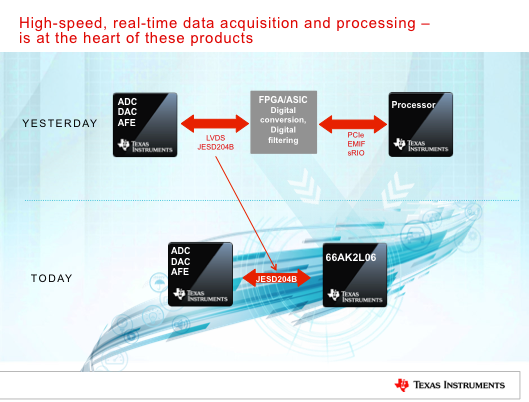TI's FPGA Killer Could Drive Medical Imaging Advances
April 21, 2015
Texas Instruments (TI; Dallas) has introduced a new system on a chip (SOC) that could make FPGAs obsolete for many applications.
Brian Buntz
|
The 66AK2L06 can do away with the need for an FPGA. Image courtesy of Texas Instruments. |
[Updated on April 22]
The TI KeyStone II (66AK2L06) SOC is said to offer 50% cost and 60% power savings over similar technologies while offering a 66% reduction in board real estate.
Part of those figures are a result of the SOC's ability to do away with FPGAs. Traditionally, FPGAs (or ASIC) were used to serve as a bridge between a processor and the analog-front-end or analog-to-digital converters or digital-to-analog converters, says Robert Ferguson, marketing director and business manager, communications processors at TI.
Now you can effectively remove the FPGA from a system with the 66AK2L06 SOC. "The 66AK2L06 is a multicore processor, so you are combining both the FPGA and the processor functions into a single SOC," says "Removing the FPGA allows for simpler trace layouts and a smaller pin count, and that helps reduce system cost. And for applications that still require an FPGA, you could take a large one out and use a much smaller one instead."
Looking at the 66AK2L06 SoC in more detail, it has two ARM Cortex-A15 MPCore processors, that can run up to 1.2 GHz each. It also has four C66x DSP cores that can also run at a maximum of 1.2 GHz. The Keystone II also has four programmable accelerators that are linked to the six cores of the SOC, and to each other.
The digital front end is software programmable. "You can do up-down conversion, programmable filters in all of those functions that were typically done before in a FPGA," Ferguson says.
The technology is well suited to medical imaging as well as other high-speed data acquisition applications such as radar and avionics as well as test and measurement applications. Within the medical realm, portable imaging applications like portable ultrasound could benefit from the technology.
But potential applications of the technology are numerous. "It can be used anywhere you are going to need that high speed analog to digital converter," Ferguson notes.
The SOC benefits from the JESD204B interface, which is faster than low-voltage differential signaling (LVDS) and complementary metal-oxide-semiconductor technologies. The majority of contemporary high-performance analog-to-digital converters and digital-to-analog converters use this interface. The JESD204B interface is an industry standard, which helps facilitate interoperability.
Another one of the key benefits of the 66AK2L06 SOC is that it can reportedly help developers get to market substantially faster--three times faster in TI's estimation based on input from their customers. "Customers have shared with us that it took them weeks to work with FPGAs versus days with the new SOC. So these data points are validated from our customers," Ferguson says. "Because it is programmable, as opposed to an FPGA, when you are programming the up-down conversion or you are programming an algorithm, such as beamforming in medical imaging applications--whether it is in fixed point or floating point--you can do all of those things directly at the C, C++ layer in software," Ferguson says.
Because everything is programmable, device developers could reconfigure algorithms or filters on the device and upgrade them once the device is on the market. "You could do a software upgrade, which allows you to potentially redefine your product after it is deployed."
Another reason behind TI's boast that the SOC can help engineers get their products to the market three times faster is the support of a program they call TI Design. "The goal of TI Design is to give customers a headstart on their product development. We have about 1500 files in the library that covers everything from powering small motor drives to more of a full system level. We are providing schematics and performance data."
Refresh your medical device industry knowledge at BIOMEDevice Boston, May 6-7, 2015. |
Brian Buntz is the editor-in-chief of MPMN and Qmed. Follow him on Twitter at @brian_buntz.
Like what you're reading? Subscribe to our daily e-newsletter.
About the Author(s)
You May Also Like


.png?width=300&auto=webp&quality=80&disable=upscale)
